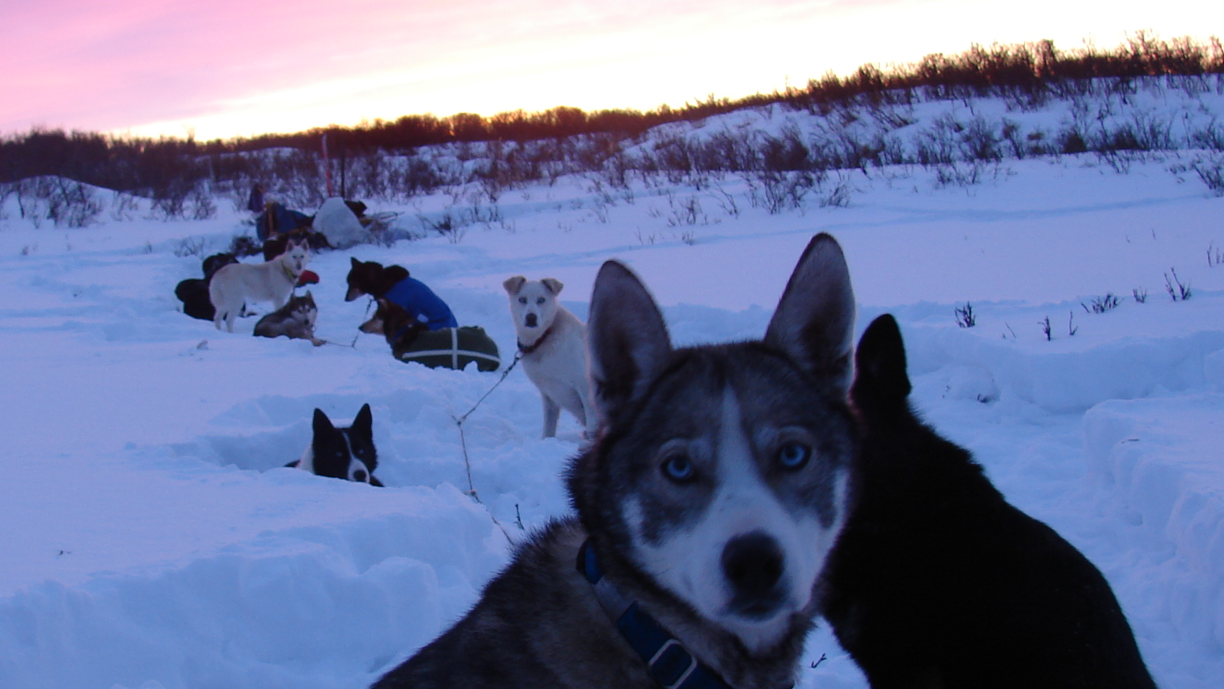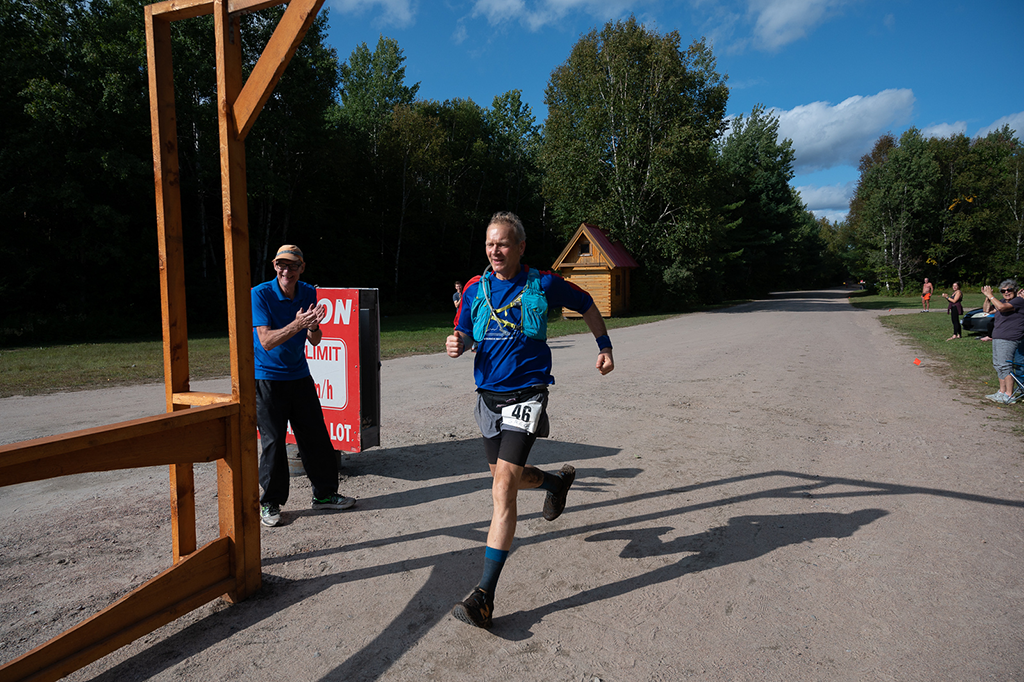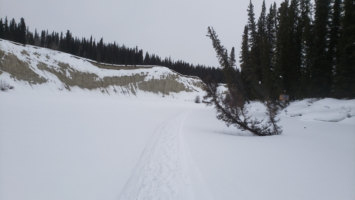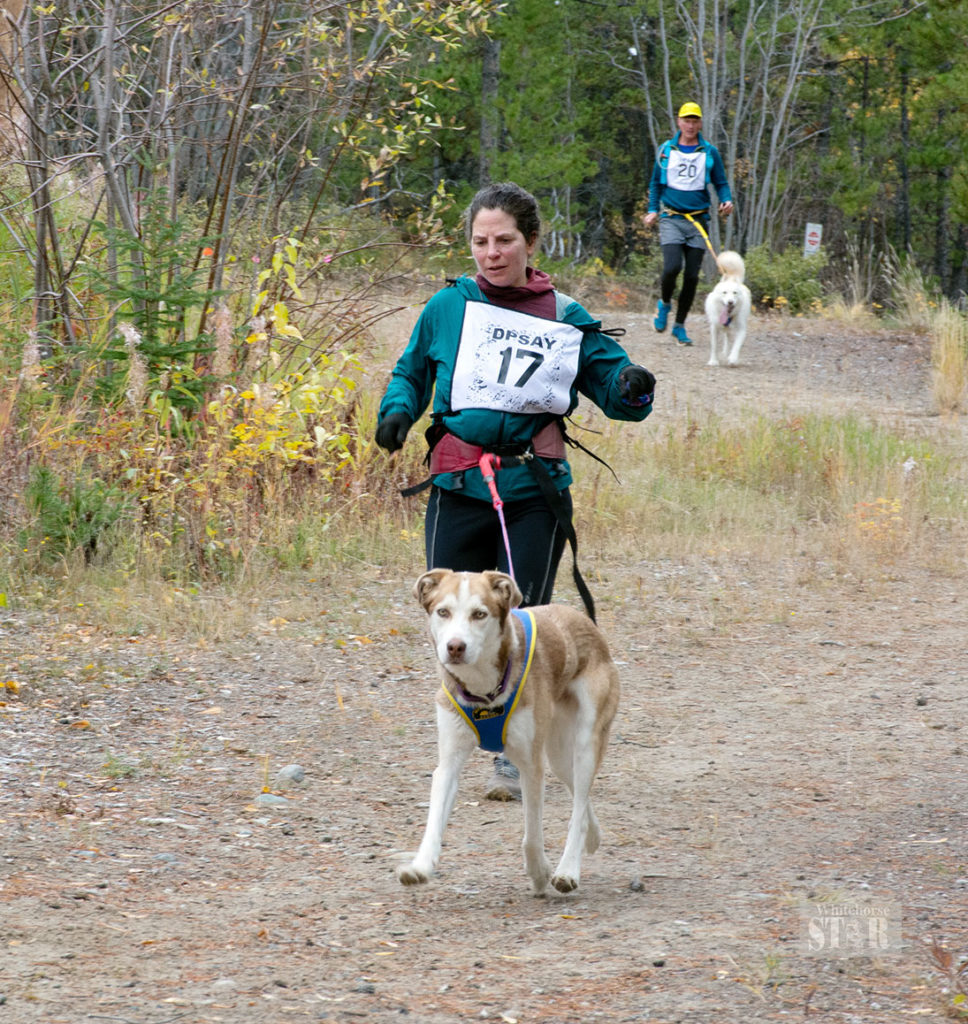I (Greg) ran the Haliburton Forest 100-mile ultramarathon on September 11-12 2021. The 100-miler is the longest of the races during this event. Around 100 runners each participated in the 100M, 50M, 50K, 26K and 12K events – each of which started an hour after the previous, to help spread out runners on the trail.
This was my third Haliburton 100 miler. I finished in 2018 after 28.5 hours. In 2019, I dropped out after 74 miles due to gastric issues and not being able to eat. In 2021, there was a significant update to the trail, and the cutoff time was changed from 30 to 33 hours, with a morning cutoff at aid station 4 at 7:00am.
The Outcome
The race began at 6am Saturday September 11. I completed the course at 4:03pm on Sunday September 12 after moving continuously, other than stops to refill water and adjust clothing and tape my feet. Total time was 34 hours 3 minutes. This was after the cutoff, but the race officials were still at the finish line to greet me. I believe two other 100M runners arrived after I did.
Getting Ready for the Trail
The trail is a 25-mile loop, which is completed two times in each direction. There are four aid stations, plus an option to stage some gear at the start/finish line. I had driven a rental car, so took advantage of leaving some extra clothing, towels, and a few other things there. I also had drop bags at all four aid stations, which mostly contained Tailwind (energy powder drink mix) and batteries for my headlamp.
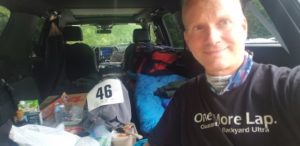
The Race
The race began at 6am, which was around 35 minutes before dawn. Temps were warmer than average, perhaps 9C/48F. There were 100 racers, all appearing to be in good spirits. The route spends perhaps 2M/3KM on a gravel road, before turning into the first section of trail (Poacher’s Trail). You can find the trail map at the race’s website, linked in the first paragraph above.
In a 100M race, most runners do not move very quickly at the start. It’s important to conserve your energy for the long race ahead. Even at the beginning, people usually walk on uphill sections. I was in the middle of the pack, sometimes passing people, and sometimes being passed. On the road, I was aiming for approximately 10-minute miles. On the trail, it’s much harder to maintain a steady pace due to the constant hills and occasional muddy sections. My running tracker told me I was generally completing miles in 11-14 minutes on the trails during the first part of the first lap.
After getting into the trail system, there is only one significant stretch of the trail that is mainly on dirt or gravel roads. It’s between AS2 and AS3. I was able to move more quickly here, occasionally running a mile in under 10 minutes. Compare this to my regular training at home, where on hilly roads I maintain 9-11 minute miles. In Whitehorse when I run on the sidewalks and paved trails, I typically run 8-9 minute miles. The Hali trail is slower going, and that is ok.
After aid station 3 is the new section of the trail. This winds along the north shore of a couple of lakes, and includes a section used in past years. This new section is 10M/16KM from AS3 to AS4. It’s all single-track and includes some very steep sections.
I completed the first 25-mile lap in 5h52m, including 3+ hours on the section from AS3 to AS4. I took a few minutes to re-tape my feet, put on new socks and a new shirt, then began lap 2. This was in the reverse direction (now heading clockwise, after lap 1 was counterclockwise). This meant I was right back on that tough new section! This time, I took closer to 3.5 hours.
By the time I had been running a few hours, I was not passing or being passed very much. I managed to be part of a few small running packs (3-5 people) who were keeping a similar pace – this is a great way to be able to just concentrate on running, without worrying as much about finding the trail or keeping a particular pace. I occasionally led these little packs, too.
During the first lap, I was passed by the leaders of the 50M race. They had started an hour after the 100-milers, but caught up and passed after I had been on the trail around 4 hours.
Head-on passes began on the last section, too. These were 100-milers and a few 50-milers who had reached the end of the first lap and were on their second. Everyone was very friendly and supportive, which is typical of other long races I’ve been a part of.
Lap 2 was uneventful, and I finished in 7h10m. Weather was unseasonably warm – around 22C/72F. There were few sections of direct sun, though, so the warmth was mostly quite pleasant. My pace had dropped somewhat, and 13- to 18-minute miles were typical depending on terrain. I was still able to maintain a good pace on those flatter sections and roads, though, in the 10- to 12-minute range.
There was a water station halfway between AS3 and AS4, where the 50KM trail intersected (mostly everyone was on the same trail, but the 50KM had some variations). I stopped for brief chat, and the photographer took a snapshot.
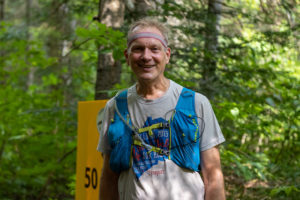
Lap 3 was starting around 7pm, so it was beginning to get dark and cooler. The weather forecast called for light rain from 10pm-4am, and low temperatures of around 10C/52F — considerably warmer than average. In past years, overnights were barely above freezing.
I had made a small mistake at the start of lap 2. Like almost all ultra runners, I wear a hydration backpack. Basically this is a pack that holds a water bladder and drinking tube, with room for various gear. I had bought a new pack (Nathan brand) a month or two earlier, which inexplicably has a continuous tube from the top to the bottom. In other words, stuff you put in can slip out the sides.
My lightweight rain jacket was falling out. Knowing it was not supposed to start raining until mid-lap3, I decided to leave my jacket at AS4 at the start of lap 2. This was a mistake, because I wouldn’t be back at AS4 for many hours. Somehow I was thinking I would be back at the start of lap 3, instead of the end of lap 3.
So, before starting lap 3, I grabbed my fleece shirt. I didn’t change from a short to long-sleeve shirt, since it was so warm – I figured the fleece shirt would be the best solution if it got colder or rained.
This was reasonable, because in fact the temps remained fairly warm, even when it began to rain at around 11pm.
My headlamp for the overnight was a Fenix brand light that uses 18650-type rechargeable batteries. This is a bright light, and the batteries last longer than AA or AAA rechargeables. I would swap out the battery at most aid stations, just to be sure. I also had a backup light, a Petzl. Visibility was fine with these lights, even though it was cloudy with no moon.
The rain that began at 11pm persisted until around 4am. Usually it was light, and it stopped for long periods. But it was heavy – pouring! – for awhile, too. I didn’t try to track the exact times, but it seems like the heavy rain was perhaps for an hour around 1am.
Surprisingly, I did not get cold. I had a cap, and was moving, and neither the rain nor the air temperature was very cold. I was ready to put on the fleece, if needed.
Sections of the trail did become very slick and puddly, however. I took one big fall, and generally was moving a lot more slowly because it was hard to find footing in the mud and the dark. After keeping my feet fairly dry all day by avoiding the muddy sections and occasional puddles, I got completely wet during lap 3 on the overnight.
The long 10M section between AS3 and AS4 was particularly challenging – there were a few sections where I needed to scramble up or down a hill, trying to hold onto trees, roots and rocks to keep from sliding in the mud.
Aid station 4 was a welcome sight! I arrived a bit before dawn on the second day, Sunday September 12. They were cooking up some breakfast foods, and – like all the aid station volunteers – friendly and supportive. I passed through fairly quickly, and completed lap 3 around 6am, for an elapsed time of around 11 hours.
I was feeling good, and knew the 7am cutoff to pass through AS4 on lap 4 was looming, so I quickly changed my shirt and got back on the trail. I was back at AS4 around 6:30am, where breakfast was underway and spirits were high. I passed several teams on their way in to finish lap 3 while I was heading out on lap 4, including many I had seen the night before. Everyone was wet, but still moving.
Later, I was surprised to learn that I was the last runner to start a return lap. Nobody else followed me – even those who could have made the 7am cutoff.
I proceeded along that long 10M section for the 4th and final time. Even though I had been moving more slowly as the race progressed, I timed the 2nd, 3rd and 4th laps and found I was consistently around 3.5 hours on that section.
When I got to AS3, I wanted to re-tape my feet. I was developing blisters and soreness on my heels and toes, and it was yielding some pain that made me go even more slowly. I find I need tape for running 20+ miles to avoid rubbing. All that rain and mud contributed to the problem, because rubbing seems to get a lot worse when everything is wet.
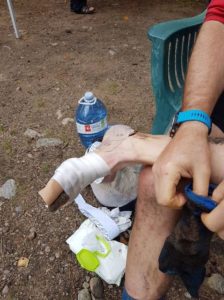
After taping up, I got back on the trail again. I was consistently running miles in over 16 minutes now, and on hilly sections even over 20 minutes. This is like walking 3 miles/hour – a pretty slow pace! But I was still moving, and feeling ok other than sore feet and a little spot in my back where my backpack was rubbing.
This wasn’t really running, at least not like at the start of the race. But it was faster than walking, and I was doing well at this slow-but-steady pace. I often maintained this slow run going uphill, whenever it was faster than trying to walk.
I had also developed some neck and shoulder pain. This was due to all the time I had spent looking downwards, to keep an eye on the trail, and look for trail markers – especially in the dark. I needed to rub my neck a bit, and tried to stretch while running.
“Not all pain is significant.”
Shortly after AS2, I was surprised to pass two other runners. Each was paired with a pacer (a companion runner for support and encouragement). We all knew that we were not going to make the 3pm cutoff, but were determined to keep going. It was super-wonderful that the aid station volunteers had waited for us, keeping our drop bags long after the rest had been returned to the finish line. There were still plenty of snacks and drinks.
I finally pulled into the finish just after 4pm. The race organizers were still there, though most participants and fans had departed. Everyone was enthusiastic, and I actually managed to speed up to a sprint to the finish line.
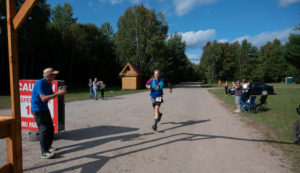
Hydration and Food
I ate almost nothing during this 100-mile race. Instead, I drank Tailwind, a nutritional drink that is specifically made to be the sole energy source during ultramarathons and similar endurance events.
It worked well. Basically, it’s sugars, salts and some flavouring. I also opted for a caffeinated mix for one of my refills. I would drink constantly, and refill my 2-liter bladder with drink mix and fresh water at every aid station.
I chose this system because of some prior problems with having a sore stomach. In 2019, this basically prevented me from eating or wanting to eat, and I bonked out after 74 miles. To manage these gastric issues, which were not limited to running, I had stopped drinking coffee in early 2020, and made other dietary changes.
But even then, I found that consuming gels and various trail food would sometimes bother my stomach. So, I tried the Tailwind, and had used it during a 75-mile practice run at home the month before. It worked well!
I still had a little bit of heartburn, but kept drinking and took occasional antacids. Towards the end of the race, I also ate a banana at the last aid stations (AS3, AS2 and AS1).
A sign of healthy hydration is urination. I had no problem with this, and knew that it meant I was keeping up with hydration needs.
After the race, I was not unduly hungry or thirsty. The next day, though, I had double-lunch and dinner, while travelling back home. I estimate I had consumed around 4000 calories of Tailwind during the race, and my tracker tells me I burned something like 10,000 calories.
Trail Conditions
This race is known for having extremely good trail marking. Thousands of surveyor flags mark the trail (many with reflective tape). Trail marking was really excellent, and I barely ever needed to stop to look for the right direction to go.
The Haliburton Forest operations crew had done some amazing trail preparation, in advance of the race. We heard this included some significant updates to the new section of trail, which previously was not well-maintained.
The trail had its grass and weeds trimmed. In previous years, I remember wading through waist-high wet grass in a few sections. This year, it had been cut and widened. There was virtually no downfall of branches, and nowhere that we needed to step over or go around fallen trees. Much better than past years!
The trail had even been blown clean of leaves, so that it was easy to see the ground and falling on slippery leaves was much less likely. The trail was in outstanding shape!
There had not been much rain, so there were relatively few puddles and muddy spots. That all changed on Saturday night, and the remainder of the race featured plenty of mud. Rain seems to be a tradition on the Haliburton race weekend.
The Community
The race organizers, participants, and spectators (most of whom were support crew) were very friendly and supportive. I couldn’t ask for a friendlier event.
In the weeks and months leading up to the event, a Facebook group seems to be the main way to converse with participants and get updates about the race. Due to the course change, some of the route information was late in arriving to the website. But generally, the race is well-managed, and especially well-supported on-site by Haliburton Forest personnel and other race staffers.
Next Time?
This is a great race, and I’d like to do it again. Since I now live on the other side of Canada, I might not opt for the long and expensive trip back east in the future. We’ll see… there are some other good ultra races in BC and Alberta I would like to explore. Many of these were cancelled in 2021, but hope springs eternal for 2022.
Closer to home, the summer ultra in Whitehorse is the Reckless Raven. This is a 50-mile race, which I completed in June 2021.
In addition, there is the Montane Yukon Arctic Ultra, a multi-distance race in February 2022. It can get mighty cold in February, which will bring its own challenges. This race requires that you carry an arctic-rated sleeping bag, cook stove, tent/bivvy, and other supplies – usually by hauling a pulk. I’m signed up for the 100-mile distance.
Afterword
For most marathon and ultramarathon runners, it’s not a race against other people. There are a few at the head of the pack who are in it for the win. For the rest of us, the competition is against the little voice in our heads that is telling us to stop and go home.
Simply finishing a 100-mile race gives a tremendous feeling of accomplishment, regardless of how long it took.
After the race, I was surprised to learn that of 96 people who started the race, only around 14 finished by the 33-hour cutoff. I was one of three people who finished after the cutoff. That means that almost 80 people did not finish, which is a much higher proportion than I would have guessed. I’m sure that some were foiled by the cutoff time at AS4 on lap 4. Others might have run into trouble during the rainy overnight and very hilly course.
Congratulations to everyone who trained for and attempted this race! Thanks for collegiality on the course. Huge thanks to the organizers and volunteers who arranged and supported the event.
